Analysis of Business Function Integration at Tesco: A Report
VerifiedAdded on 2020/02/05
|17
|4434
|660
Report
AI Summary
This report provides a comprehensive analysis of Tesco's business functions, exploring key areas such as marketing, finance, and leadership. It examines Tesco's organizational structure, highlighting its hierarchical nature and the evolution of its leadership styles from autocratic to participative. The report delves into the specific functions of marketing, finance, and research and development, detailing their objectives and strategies. Furthermore, it conducts internal and external analyses using SWOT and STEEP models, identifying Tesco's strengths, weaknesses, opportunities, and threats, as well as the impact of social, economic, environmental, and political factors. The report also applies Porter's five forces analysis to assess the competitive landscape of the retail supermarket industry, evaluating the threats of substitute products, rivalry among existing companies, and the bargaining power of suppliers and buyers. Overall, the report offers valuable insights into Tesco's strategic approach to business function integration and its competitive positioning within the market.
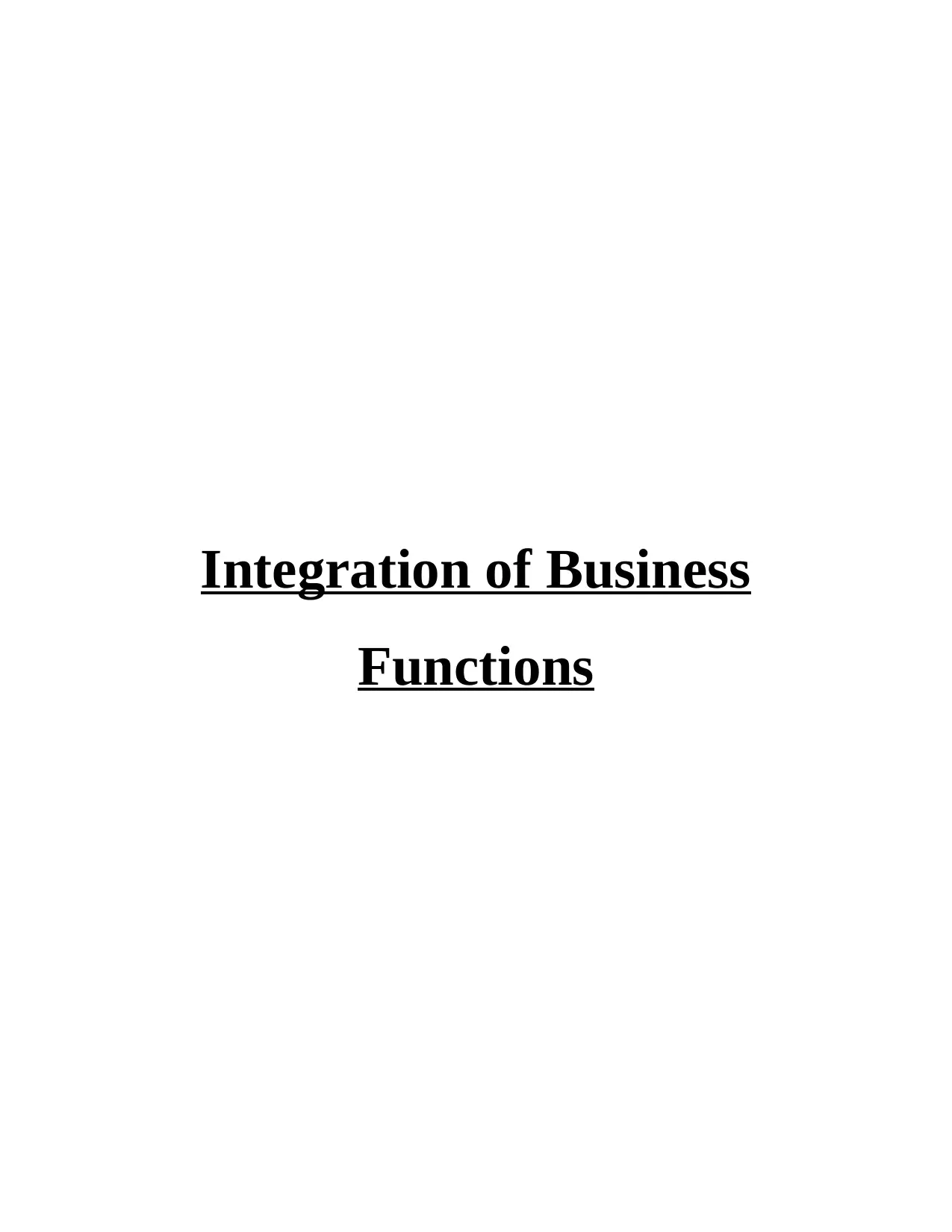
Integration of Business
Functions
Functions
Paraphrase This Document
Need a fresh take? Get an instant paraphrase of this document with our AI Paraphraser
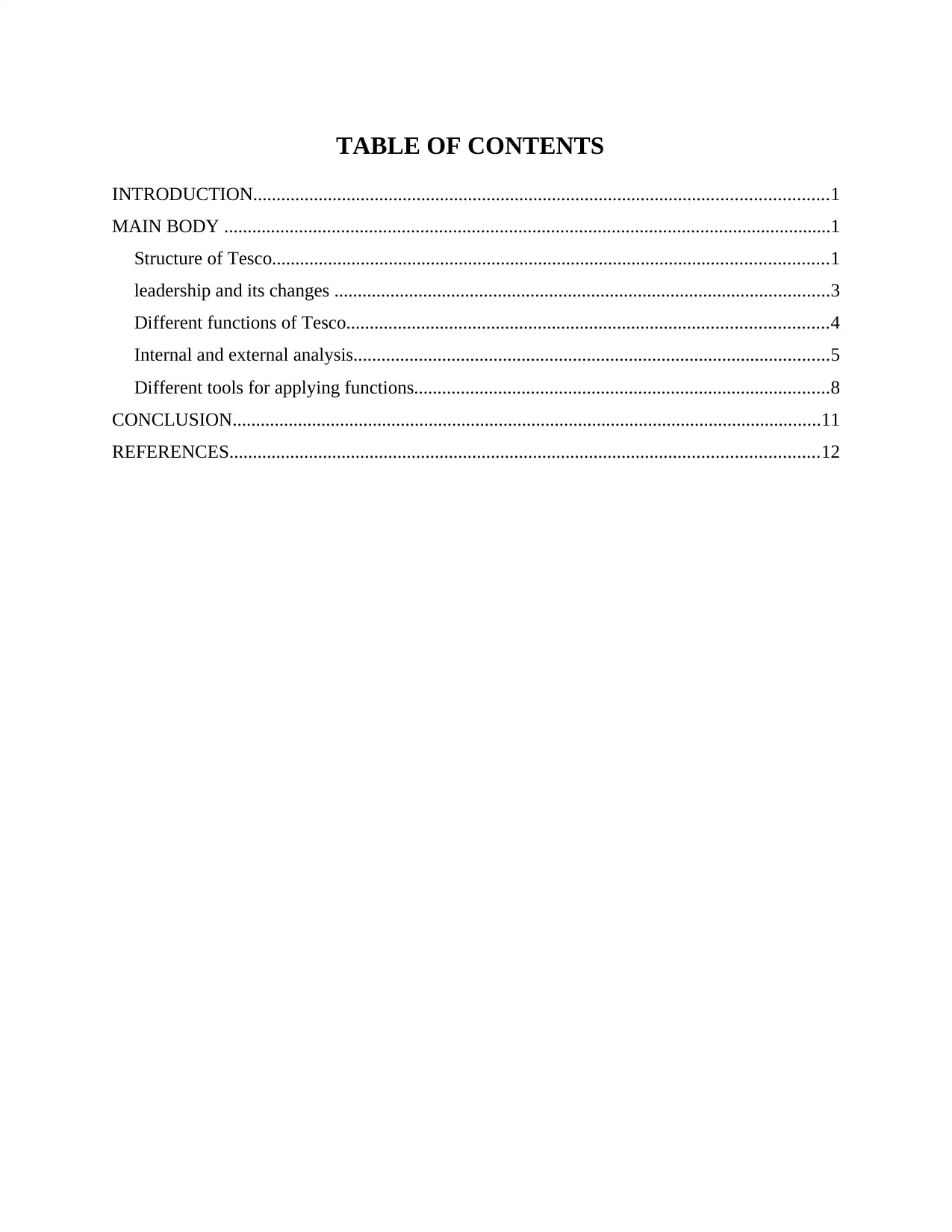
TABLE OF CONTENTS
INTRODUCTION...........................................................................................................................1
MAIN BODY ..................................................................................................................................1
Structure of Tesco.......................................................................................................................1
leadership and its changes ..........................................................................................................3
Different functions of Tesco.......................................................................................................4
Internal and external analysis......................................................................................................5
Different tools for applying functions.........................................................................................8
CONCLUSION..............................................................................................................................11
REFERENCES..............................................................................................................................12
INTRODUCTION...........................................................................................................................1
MAIN BODY ..................................................................................................................................1
Structure of Tesco.......................................................................................................................1
leadership and its changes ..........................................................................................................3
Different functions of Tesco.......................................................................................................4
Internal and external analysis......................................................................................................5
Different tools for applying functions.........................................................................................8
CONCLUSION..............................................................................................................................11
REFERENCES..............................................................................................................................12
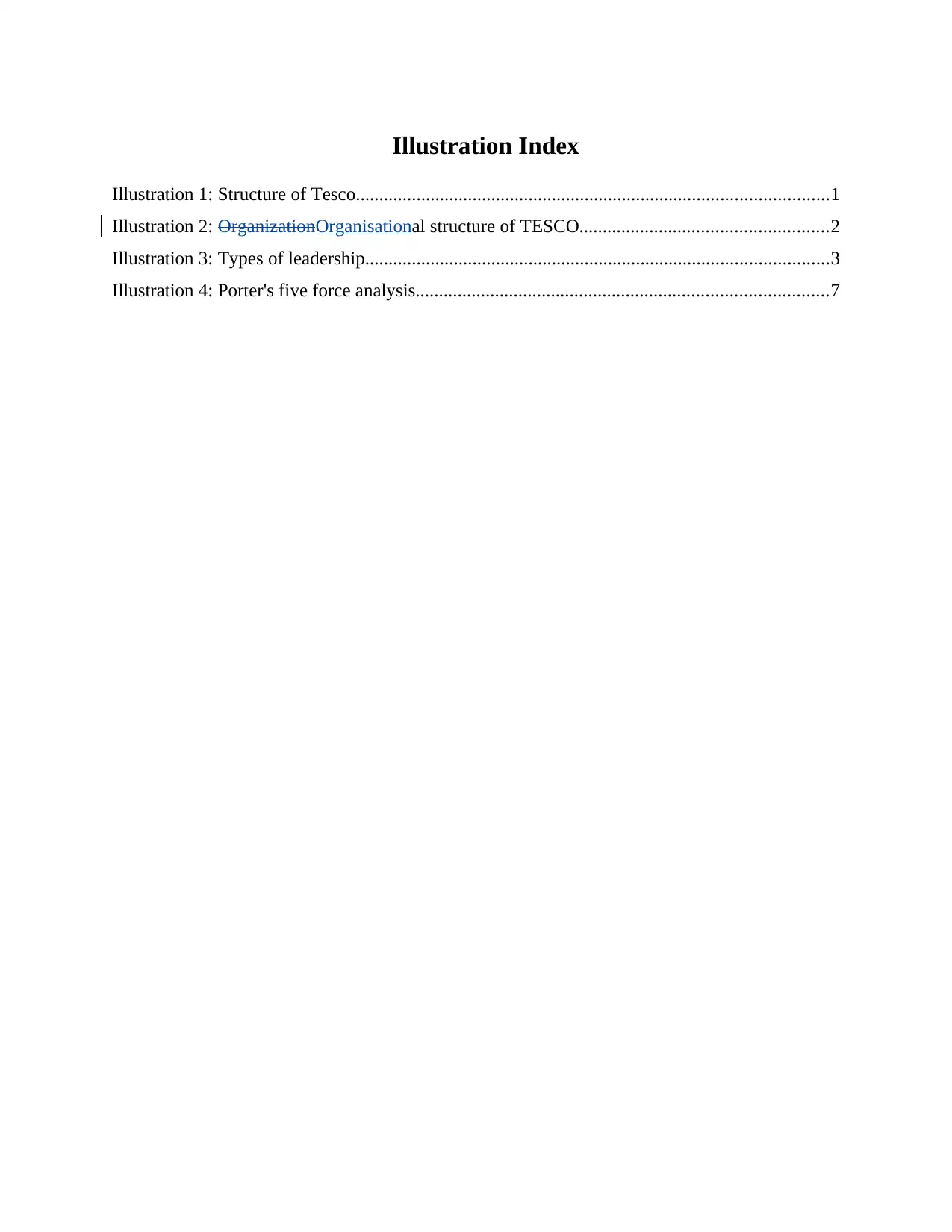
Illustration Index
Illustration 1: Structure of Tesco.....................................................................................................1
Illustration 2: OrganizationOrganisational structure of TESCO.....................................................2
Illustration 3: Types of leadership...................................................................................................3
Illustration 4: Porter's five force analysis........................................................................................7
Illustration 1: Structure of Tesco.....................................................................................................1
Illustration 2: OrganizationOrganisational structure of TESCO.....................................................2
Illustration 3: Types of leadership...................................................................................................3
Illustration 4: Porter's five force analysis........................................................................................7
⊘ This is a preview!⊘
Do you want full access?
Subscribe today to unlock all pages.

Trusted by 1+ million students worldwide

INTRODUCTION
Research and Development, Marketing, Financing/Accounting, these four are the main functions
exist in an organizationorganisation (Brannen, Piekkari and Tietze, 2014). Tesco is one of the
biggest supermarket company in UK. Tesco was established in 1929, the strategy at that time
was “Sell it cheap and Pile it high”. In previous years the company was having its grocery and
merchandising retail stores. As the market and trend is changing, Tesco is adapting to those
changes and after cementing their place in food industry, they are now involving themselves in
different otherareas like clothes, electronics, internet services and music industry (Dillon,
2015Dillon, 2015).
This essay consists of all the long term strategies used by the company in the last 10
years. The mantra of Tesco is to serve UK's shoppers in a better way. The aim of these strategies
is to grow the core business, and to become a successful retail company internationally. Some of
the functions used in Tesco like marketing, accounting, finance have also been discussed in this
essay.
MAIN BODY
Structure of Tesco
The organizationorganisational structure followed by Tesco is highly hierarchical. This is
reflecting the major proportion of business (Nakamura and Suzuki, 2015). The governing
structure of Tesco consists of five committee, which well report to the board of PLC. The board
will be having 11 members which led by the chief executive.
1
Research and Development, Marketing, Financing/Accounting, these four are the main functions
exist in an organizationorganisation (Brannen, Piekkari and Tietze, 2014). Tesco is one of the
biggest supermarket company in UK. Tesco was established in 1929, the strategy at that time
was “Sell it cheap and Pile it high”. In previous years the company was having its grocery and
merchandising retail stores. As the market and trend is changing, Tesco is adapting to those
changes and after cementing their place in food industry, they are now involving themselves in
different otherareas like clothes, electronics, internet services and music industry (Dillon,
2015Dillon, 2015).
This essay consists of all the long term strategies used by the company in the last 10
years. The mantra of Tesco is to serve UK's shoppers in a better way. The aim of these strategies
is to grow the core business, and to become a successful retail company internationally. Some of
the functions used in Tesco like marketing, accounting, finance have also been discussed in this
essay.
MAIN BODY
Structure of Tesco
The organizationorganisational structure followed by Tesco is highly hierarchical. This is
reflecting the major proportion of business (Nakamura and Suzuki, 2015). The governing
structure of Tesco consists of five committee, which well report to the board of PLC. The board
will be having 11 members which led by the chief executive.
1
Paraphrase This Document
Need a fresh take? Get an instant paraphrase of this document with our AI Paraphraser
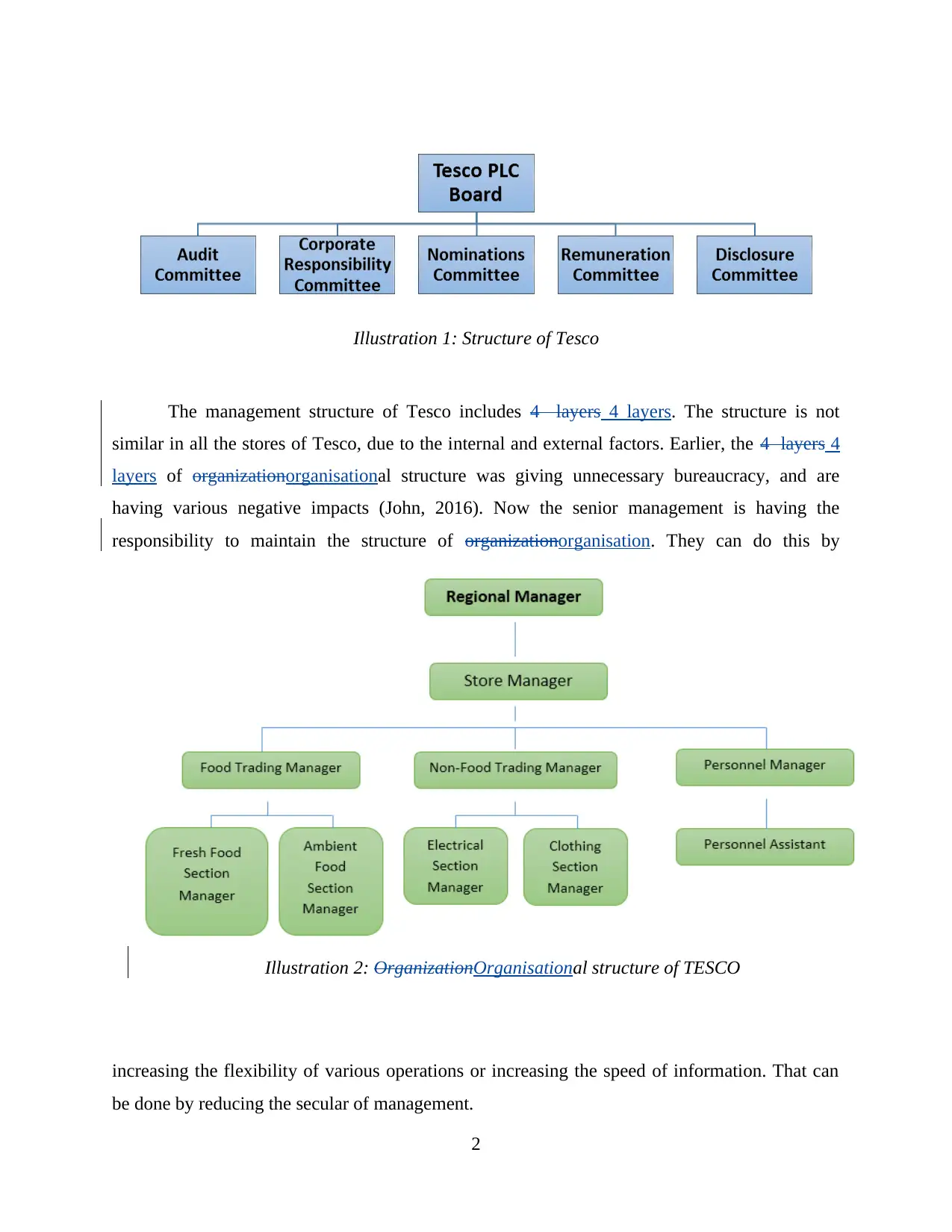
The management structure of Tesco includes 4 layers 4 layers. The structure is not
similar in all the stores of Tesco, due to the internal and external factors. Earlier, the 4 layers 4
layers of organizationorganisational structure was giving unnecessary bureaucracy, and are
having various negative impacts (John, 2016). Now the senior management is having the
responsibility to maintain the structure of organizationorganisation. They can do this by
increasing the flexibility of various operations or increasing the speed of information. That can
be done by reducing the secular of management.
2
Illustration 1: Structure of Tesco
Illustration 2: OrganizationOrganisational structure of TESCO
similar in all the stores of Tesco, due to the internal and external factors. Earlier, the 4 layers 4
layers of organizationorganisational structure was giving unnecessary bureaucracy, and are
having various negative impacts (John, 2016). Now the senior management is having the
responsibility to maintain the structure of organizationorganisation. They can do this by
increasing the flexibility of various operations or increasing the speed of information. That can
be done by reducing the secular of management.
2
Illustration 1: Structure of Tesco
Illustration 2: OrganizationOrganisational structure of TESCO
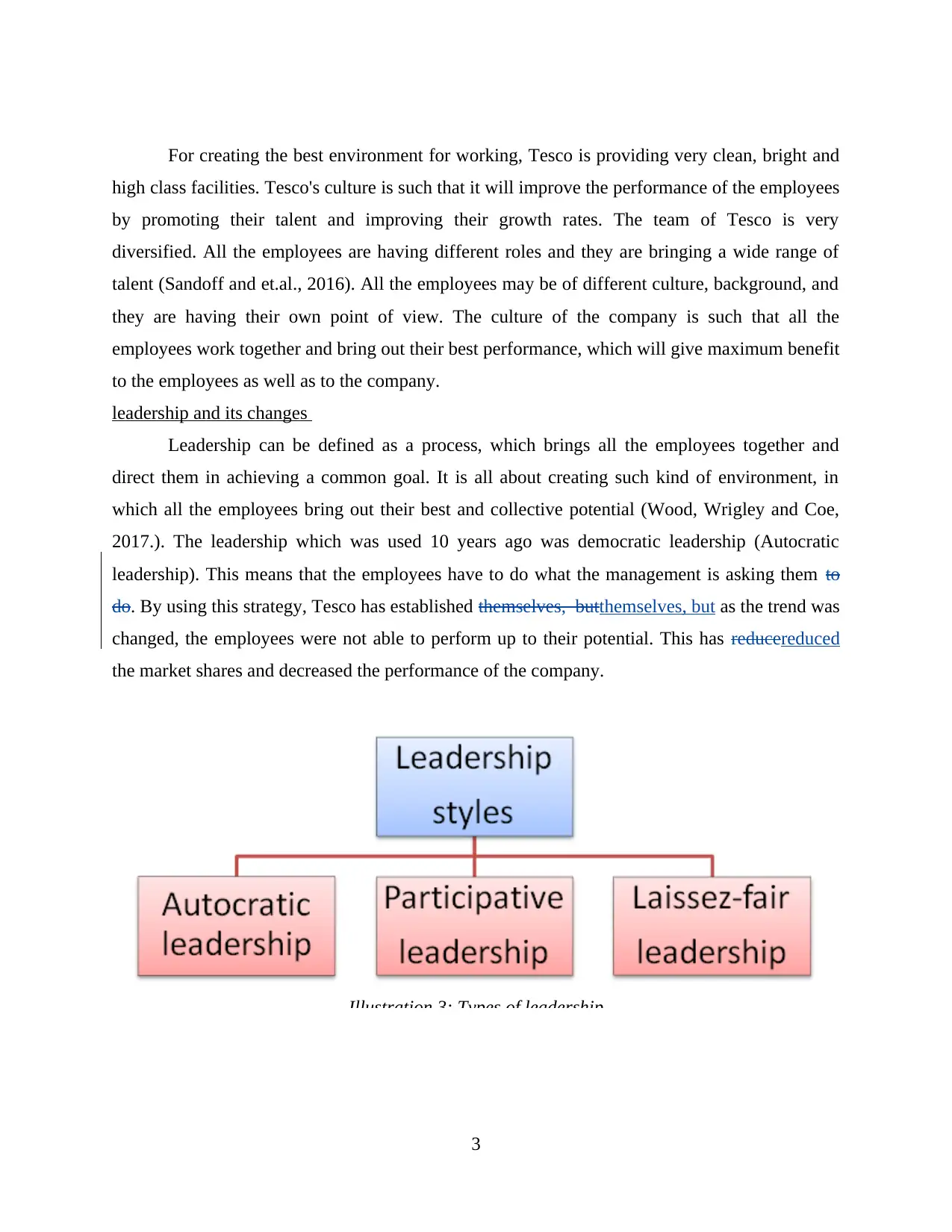
For creating the best environment for working, Tesco is providing very clean, bright and
high class facilities. Tesco's culture is such that it will improve the performance of the employees
by promoting their talent and improving their growth rates. The team of Tesco is very
diversified. All the employees are having different roles and they are bringing a wide range of
talent (Sandoff and et.al., 2016). All the employees may be of different culture, background, and
they are having their own point of view. The culture of the company is such that all the
employees work together and bring out their best performance, which will give maximum benefit
to the employees as well as to the company.
leadership and its changes
Leadership can be defined as a process, which brings all the employees together and
direct them in achieving a common goal. It is all about creating such kind of environment, in
which all the employees bring out their best and collective potential (Wood, Wrigley and Coe,
2017.). The leadership which was used 10 years ago was democratic leadership (Autocratic
leadership). This means that the employees have to do what the management is asking them to
do. By using this strategy, Tesco has established themselves, butthemselves, but as the trend was
changed, the employees were not able to perform up to their potential. This has reducereduced
the market shares and decreased the performance of the company.
3
Illustration 3: Types of leadership
high class facilities. Tesco's culture is such that it will improve the performance of the employees
by promoting their talent and improving their growth rates. The team of Tesco is very
diversified. All the employees are having different roles and they are bringing a wide range of
talent (Sandoff and et.al., 2016). All the employees may be of different culture, background, and
they are having their own point of view. The culture of the company is such that all the
employees work together and bring out their best performance, which will give maximum benefit
to the employees as well as to the company.
leadership and its changes
Leadership can be defined as a process, which brings all the employees together and
direct them in achieving a common goal. It is all about creating such kind of environment, in
which all the employees bring out their best and collective potential (Wood, Wrigley and Coe,
2017.). The leadership which was used 10 years ago was democratic leadership (Autocratic
leadership). This means that the employees have to do what the management is asking them to
do. By using this strategy, Tesco has established themselves, butthemselves, but as the trend was
changed, the employees were not able to perform up to their potential. This has reducereduced
the market shares and decreased the performance of the company.
3
Illustration 3: Types of leadership
⊘ This is a preview!⊘
Do you want full access?
Subscribe today to unlock all pages.

Trusted by 1+ million students worldwide
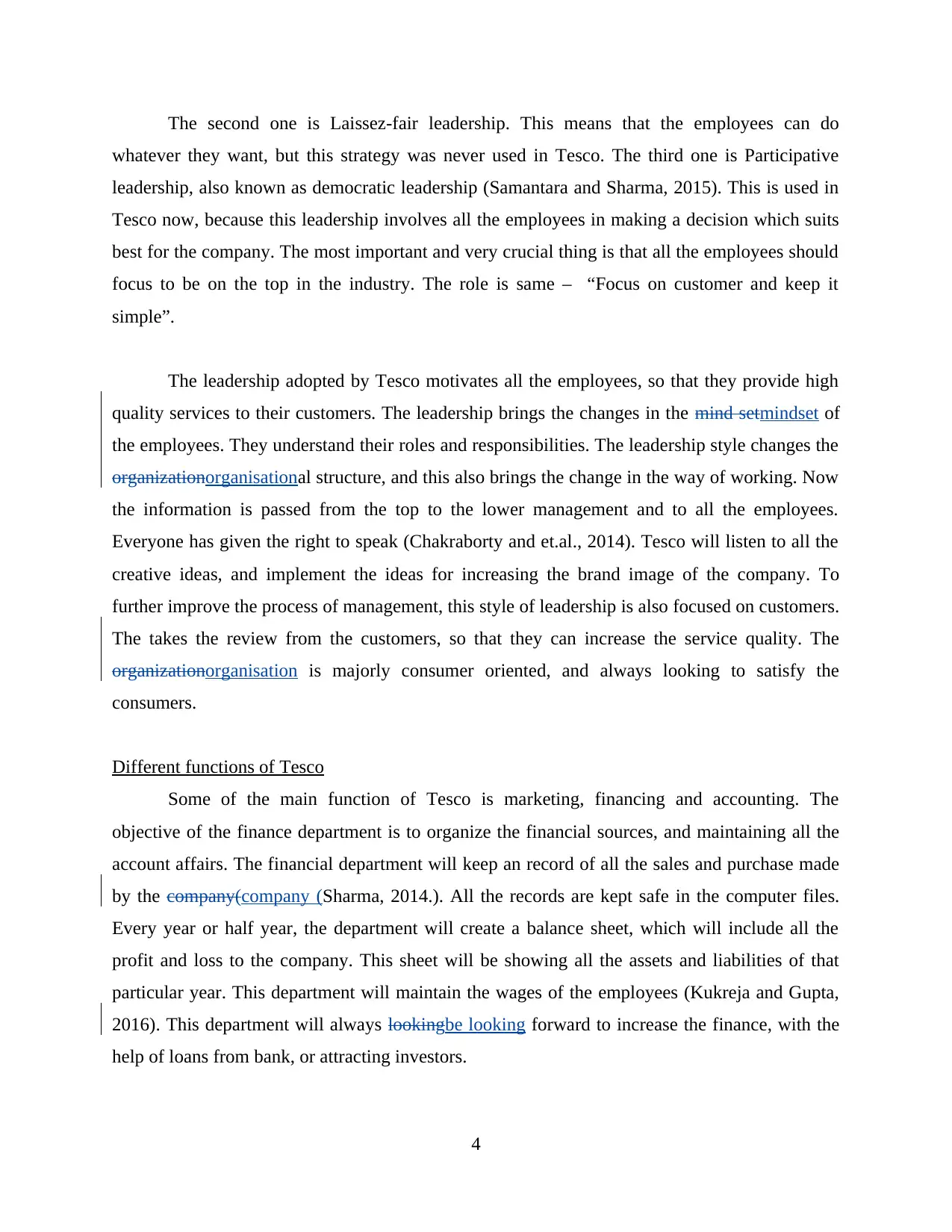
The second one is Laissez-fair leadership. This means that the employees can do
whatever they want, but this strategy was never used in Tesco. The third one is Participative
leadership, also known as democratic leadership (Samantara and Sharma, 2015). This is used in
Tesco now, because this leadership involves all the employees in making a decision which suits
best for the company. The most important and very crucial thing is that all the employees should
focus to be on the top in the industry. The role is same – “Focus on customer and keep it
simple”.
The leadership adopted by Tesco motivates all the employees, so that they provide high
quality services to their customers. The leadership brings the changes in the mind setmindset of
the employees. They understand their roles and responsibilities. The leadership style changes the
organizationorganisational structure, and this also brings the change in the way of working. Now
the information is passed from the top to the lower management and to all the employees.
Everyone has given the right to speak (Chakraborty and et.al., 2014). Tesco will listen to all the
creative ideas, and implement the ideas for increasing the brand image of the company. To
further improve the process of management, this style of leadership is also focused on customers.
The takes the review from the customers, so that they can increase the service quality. The
organizationorganisation is majorly consumer oriented, and always looking to satisfy the
consumers.
Different functions of Tesco
Some of the main function of Tesco is marketing, financing and accounting. The
objective of the finance department is to organize the financial sources, and maintaining all the
account affairs. The financial department will keep an record of all the sales and purchase made
by the company(company (Sharma, 2014.). All the records are kept safe in the computer files.
Every year or half year, the department will create a balance sheet, which will include all the
profit and loss to the company. This sheet will be showing all the assets and liabilities of that
particular year. This department will maintain the wages of the employees (Kukreja and Gupta,
2016). This department will always lookingbe looking forward to increase the finance, with the
help of loans from bank, or attracting investors.
4
whatever they want, but this strategy was never used in Tesco. The third one is Participative
leadership, also known as democratic leadership (Samantara and Sharma, 2015). This is used in
Tesco now, because this leadership involves all the employees in making a decision which suits
best for the company. The most important and very crucial thing is that all the employees should
focus to be on the top in the industry. The role is same – “Focus on customer and keep it
simple”.
The leadership adopted by Tesco motivates all the employees, so that they provide high
quality services to their customers. The leadership brings the changes in the mind setmindset of
the employees. They understand their roles and responsibilities. The leadership style changes the
organizationorganisational structure, and this also brings the change in the way of working. Now
the information is passed from the top to the lower management and to all the employees.
Everyone has given the right to speak (Chakraborty and et.al., 2014). Tesco will listen to all the
creative ideas, and implement the ideas for increasing the brand image of the company. To
further improve the process of management, this style of leadership is also focused on customers.
The takes the review from the customers, so that they can increase the service quality. The
organizationorganisation is majorly consumer oriented, and always looking to satisfy the
consumers.
Different functions of Tesco
Some of the main function of Tesco is marketing, financing and accounting. The
objective of the finance department is to organize the financial sources, and maintaining all the
account affairs. The financial department will keep an record of all the sales and purchase made
by the company(company (Sharma, 2014.). All the records are kept safe in the computer files.
Every year or half year, the department will create a balance sheet, which will include all the
profit and loss to the company. This sheet will be showing all the assets and liabilities of that
particular year. This department will maintain the wages of the employees (Kukreja and Gupta,
2016). This department will always lookingbe looking forward to increase the finance, with the
help of loans from bank, or attracting investors.
4
Paraphrase This Document
Need a fresh take? Get an instant paraphrase of this document with our AI Paraphraser
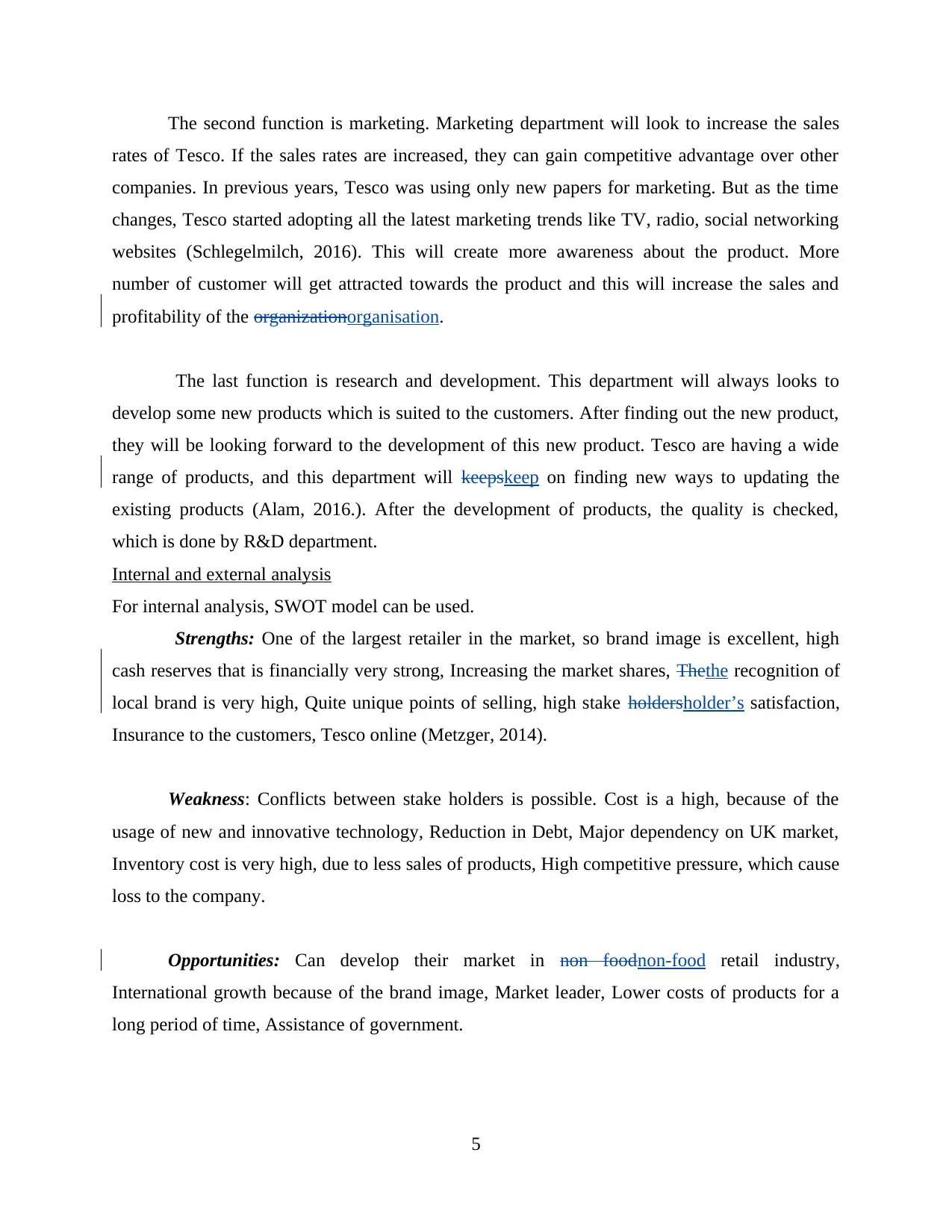
The second function is marketing. Marketing department will look to increase the sales
rates of Tesco. If the sales rates are increased, they can gain competitive advantage over other
companies. In previous years, Tesco was using only new papers for marketing. But as the time
changes, Tesco started adopting all the latest marketing trends like TV, radio, social networking
websites (Schlegelmilch, 2016). This will create more awareness about the product. More
number of customer will get attracted towards the product and this will increase the sales and
profitability of the organizationorganisation.
The last function is research and development. This department will always looks to
develop some new products which is suited to the customers. After finding out the new product,
they will be looking forward to the development of this new product. Tesco are having a wide
range of products, and this department will keepskeep on finding new ways to updating the
existing products (Alam, 2016.). After the development of products, the quality is checked,
which is done by R&D department.
Internal and external analysis
For internal analysis, SWOT model can be used.
Strengths: One of the largest retailer in the market, so brand image is excellent, high
cash reserves that is financially very strong, Increasing the market shares, Thethe recognition of
local brand is very high, Quite unique points of selling, high stake holdersholder’s satisfaction,
Insurance to the customers, Tesco online (Metzger, 2014).
Weakness: Conflicts between stake holders is possible. Cost is a high, because of the
usage of new and innovative technology, Reduction in Debt, Major dependency on UK market,
Inventory cost is very high, due to less sales of products, High competitive pressure, which cause
loss to the company.
Opportunities: Can develop their market in non foodnon-food retail industry,
International growth because of the brand image, Market leader, Lower costs of products for a
long period of time, Assistance of government.
5
rates of Tesco. If the sales rates are increased, they can gain competitive advantage over other
companies. In previous years, Tesco was using only new papers for marketing. But as the time
changes, Tesco started adopting all the latest marketing trends like TV, radio, social networking
websites (Schlegelmilch, 2016). This will create more awareness about the product. More
number of customer will get attracted towards the product and this will increase the sales and
profitability of the organizationorganisation.
The last function is research and development. This department will always looks to
develop some new products which is suited to the customers. After finding out the new product,
they will be looking forward to the development of this new product. Tesco are having a wide
range of products, and this department will keepskeep on finding new ways to updating the
existing products (Alam, 2016.). After the development of products, the quality is checked,
which is done by R&D department.
Internal and external analysis
For internal analysis, SWOT model can be used.
Strengths: One of the largest retailer in the market, so brand image is excellent, high
cash reserves that is financially very strong, Increasing the market shares, Thethe recognition of
local brand is very high, Quite unique points of selling, high stake holdersholder’s satisfaction,
Insurance to the customers, Tesco online (Metzger, 2014).
Weakness: Conflicts between stake holders is possible. Cost is a high, because of the
usage of new and innovative technology, Reduction in Debt, Major dependency on UK market,
Inventory cost is very high, due to less sales of products, High competitive pressure, which cause
loss to the company.
Opportunities: Can develop their market in non foodnon-food retail industry,
International growth because of the brand image, Market leader, Lower costs of products for a
long period of time, Assistance of government.
5
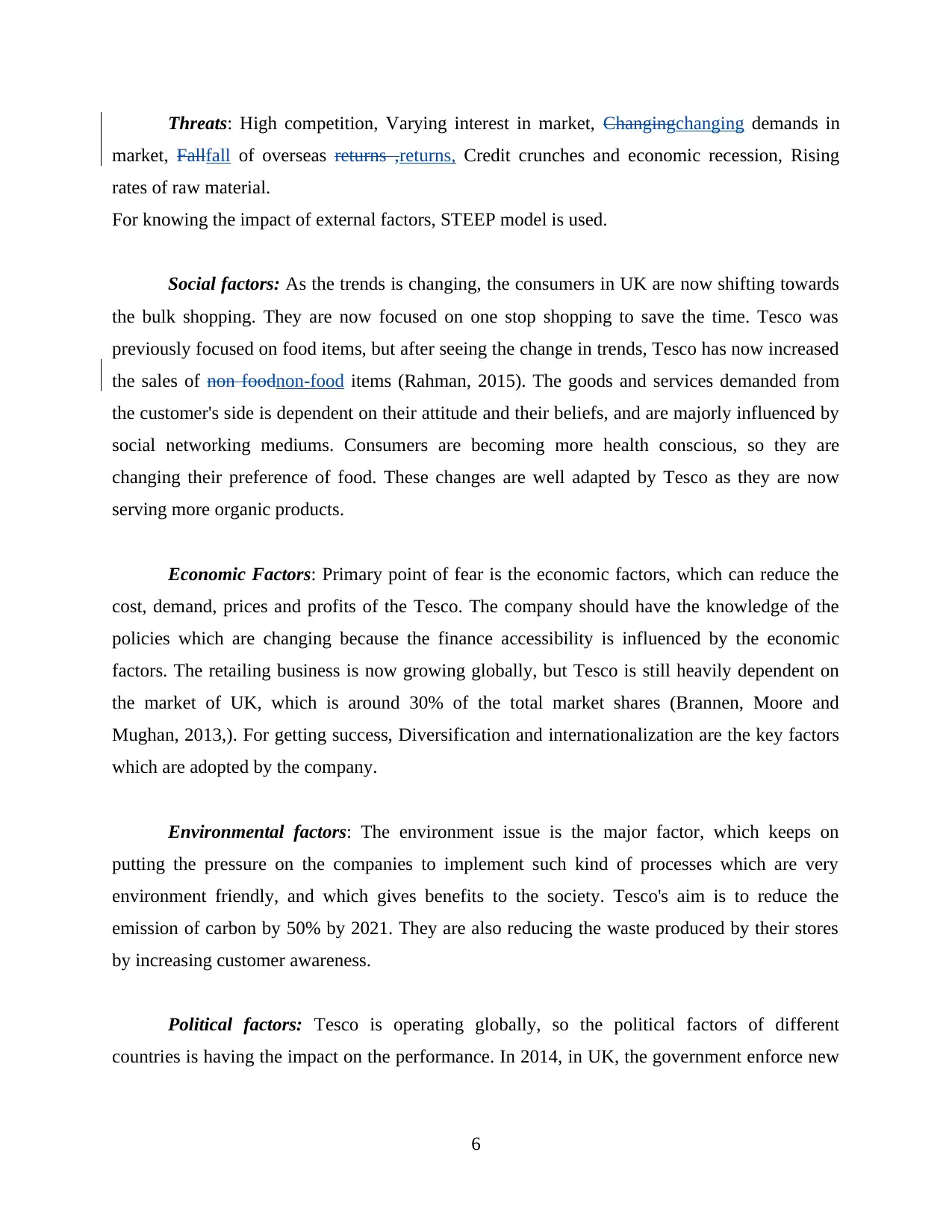
Threats: High competition, Varying interest in market, Changingchanging demands in
market, Fallfall of overseas returns ,returns, Credit crunches and economic recession, Rising
rates of raw material.
For knowing the impact of external factors, STEEP model is used.
Social factors: As the trends is changing, the consumers in UK are now shifting towards
the bulk shopping. They are now focused on one stop shopping to save the time. Tesco was
previously focused on food items, but after seeing the change in trends, Tesco has now increased
the sales of non foodnon-food items (Rahman, 2015). The goods and services demanded from
the customer's side is dependent on their attitude and their beliefs, and are majorly influenced by
social networking mediums. Consumers are becoming more health conscious, so they are
changing their preference of food. These changes are well adapted by Tesco as they are now
serving more organic products.
Economic Factors: Primary point of fear is the economic factors, which can reduce the
cost, demand, prices and profits of the Tesco. The company should have the knowledge of the
policies which are changing because the finance accessibility is influenced by the economic
factors. The retailing business is now growing globally, but Tesco is still heavily dependent on
the market of UK, which is around 30% of the total market shares (Brannen, Moore and
Mughan, 2013,). For getting success, Diversification and internationalization are the key factors
which are adopted by the company.
Environmental factors: The environment issue is the major factor, which keeps on
putting the pressure on the companies to implement such kind of processes which are very
environment friendly, and which gives benefits to the society. Tesco's aim is to reduce the
emission of carbon by 50% by 2021. They are also reducing the waste produced by their stores
by increasing customer awareness.
Political factors: Tesco is operating globally, so the political factors of different
countries is having the impact on the performance. In 2014, in UK, the government enforce new
6
market, Fallfall of overseas returns ,returns, Credit crunches and economic recession, Rising
rates of raw material.
For knowing the impact of external factors, STEEP model is used.
Social factors: As the trends is changing, the consumers in UK are now shifting towards
the bulk shopping. They are now focused on one stop shopping to save the time. Tesco was
previously focused on food items, but after seeing the change in trends, Tesco has now increased
the sales of non foodnon-food items (Rahman, 2015). The goods and services demanded from
the customer's side is dependent on their attitude and their beliefs, and are majorly influenced by
social networking mediums. Consumers are becoming more health conscious, so they are
changing their preference of food. These changes are well adapted by Tesco as they are now
serving more organic products.
Economic Factors: Primary point of fear is the economic factors, which can reduce the
cost, demand, prices and profits of the Tesco. The company should have the knowledge of the
policies which are changing because the finance accessibility is influenced by the economic
factors. The retailing business is now growing globally, but Tesco is still heavily dependent on
the market of UK, which is around 30% of the total market shares (Brannen, Moore and
Mughan, 2013,). For getting success, Diversification and internationalization are the key factors
which are adopted by the company.
Environmental factors: The environment issue is the major factor, which keeps on
putting the pressure on the companies to implement such kind of processes which are very
environment friendly, and which gives benefits to the society. Tesco's aim is to reduce the
emission of carbon by 50% by 2021. They are also reducing the waste produced by their stores
by increasing customer awareness.
Political factors: Tesco is operating globally, so the political factors of different
countries is having the impact on the performance. In 2014, in UK, the government enforce new
6
⊘ This is a preview!⊘
Do you want full access?
Subscribe today to unlock all pages.

Trusted by 1+ million students worldwide

tax rules for the supermarkets, this was also known as Tesco Tax. This kind of rules result in
increase in price range and reduce the profitability of Tesco.
Porter's five force analysis
This analysis is done to find out the level of competition in the retail supermarket
industry. The five forces are;
Threat of substitute products: The products sells by Tesco are having a wide range.
Some of the products are clothing, technology and gaming, home appliances, electrical
appliances, toys, health and beauty etc. These products are highly encompassing. The other
companies in retail industry are selling the same kind of product and that too on the same price
range. Therefore, it is clear that the threat of substitute products areis high for Tesco.
Rivalry among existing companies: Advertising expenditure and variety of services and
products are the major factor which are having an impact on the competitiveness in retail
industry. The costs are similar for the products, which increases the intensity of competition. But
Tesco keeps on maintaining leadership, when it comes to retail industry.
7
Illustration 4: Porter's five force analysis
increase in price range and reduce the profitability of Tesco.
Porter's five force analysis
This analysis is done to find out the level of competition in the retail supermarket
industry. The five forces are;
Threat of substitute products: The products sells by Tesco are having a wide range.
Some of the products are clothing, technology and gaming, home appliances, electrical
appliances, toys, health and beauty etc. These products are highly encompassing. The other
companies in retail industry are selling the same kind of product and that too on the same price
range. Therefore, it is clear that the threat of substitute products areis high for Tesco.
Rivalry among existing companies: Advertising expenditure and variety of services and
products are the major factor which are having an impact on the competitiveness in retail
industry. The costs are similar for the products, which increases the intensity of competition. But
Tesco keeps on maintaining leadership, when it comes to retail industry.
7
Illustration 4: Porter's five force analysis
Paraphrase This Document
Need a fresh take? Get an instant paraphrase of this document with our AI Paraphraser

Bargaining Power of suppliers: GenerallyGenerally, it is low. Tesco is having hundreds
of suppliers, so there are minimum chance that supplier will change the cost of the products.
Therefore, Tesco can negotiate from the suppliers, so that they can get the lowest price possible.
Bargaining Power of Buyer: The negotiating power of the consumers is very high. There
are very similar products which are offered by the retailers, so very low chances are there for the
price change. Therefore, the buyer can easily change Chakraborty, R., and et.al., 2014their mark
from one company to another. Tesco is offering the products on the lowest price, so that they can
attract more number of customers.
Threat of new entrants: This is very low. Because to start a new retail business, it will
require a huge capital amount, so that the firm can establish their mark in front of already
established companies like Tesco, Sainsbury. Tesco is operating on more than 30% retail market
in UK, and their brand image is very high. SoSo, it is very unlikely that they will be facing the
threat from the new entrants.
Different tools for applying functions
Motivation strategy, recruitment selection strategy are those tools which can be used to
bring up the functions. Motivation strategy is the first step adopted by Tesco, in order to keeping
safesafe, the personal interest of the employees from the external; factors. There are several
theories which has been given for motivating the employees. The pay scale is considered as the
premier motivator (Alegbejo, 2013). Motivating factors like giving incentives, praise the
employee can also be used for motivating the workers. Taylor's motivation theory can be used by
Tesco. In this theory, the workers were getting paid by the per produced item (Chen and
Lamberti, 2016).
This approach was good and it certainly increased the output. But it has given very less
opportunity or time to the employees to think in a more creative way. This results in very limited
skill development of people and their use (Yamuna and Devi, 2016). Tesco's reward program for
their employees is also an motivating factor. They are giving each employee the reward they
8
of suppliers, so there are minimum chance that supplier will change the cost of the products.
Therefore, Tesco can negotiate from the suppliers, so that they can get the lowest price possible.
Bargaining Power of Buyer: The negotiating power of the consumers is very high. There
are very similar products which are offered by the retailers, so very low chances are there for the
price change. Therefore, the buyer can easily change Chakraborty, R., and et.al., 2014their mark
from one company to another. Tesco is offering the products on the lowest price, so that they can
attract more number of customers.
Threat of new entrants: This is very low. Because to start a new retail business, it will
require a huge capital amount, so that the firm can establish their mark in front of already
established companies like Tesco, Sainsbury. Tesco is operating on more than 30% retail market
in UK, and their brand image is very high. SoSo, it is very unlikely that they will be facing the
threat from the new entrants.
Different tools for applying functions
Motivation strategy, recruitment selection strategy are those tools which can be used to
bring up the functions. Motivation strategy is the first step adopted by Tesco, in order to keeping
safesafe, the personal interest of the employees from the external; factors. There are several
theories which has been given for motivating the employees. The pay scale is considered as the
premier motivator (Alegbejo, 2013). Motivating factors like giving incentives, praise the
employee can also be used for motivating the workers. Taylor's motivation theory can be used by
Tesco. In this theory, the workers were getting paid by the per produced item (Chen and
Lamberti, 2016).
This approach was good and it certainly increased the output. But it has given very less
opportunity or time to the employees to think in a more creative way. This results in very limited
skill development of people and their use (Yamuna and Devi, 2016). Tesco's reward program for
their employees is also an motivating factor. They are giving each employee the reward they
8

deserve when they reach a set target. Every year Tesco is organizing staff satisfaction survey,
which gives an opportunity to each employee to express their feelings from all the aspects of the
job. The result will make sure Tesco are giving all the right things to their employees. This will
keep them motivated.
The Mayo effect is another theory which can be used for motivating staff. This theory
suggestsuggests that both internal and external factors can be used in motivating the person to
develop their skills. The internal factors can be the tendency of learning new and innovative
skills. The external factors may include the incentives, Tesco is offering for the sales target. The
motivation can be increased by good communication and teamwork, involving all the employees
in decision making. Tesco makes sure that the work employees are doing should be interesting
and non-repetitive.
Tesco is promoting motivation by the help of various training and development program.
The main idea of such kind of program is to “Take people with you” and “Gain the hearts of
other”, so that it will improve the skills of an individual and the things can get done very easily
and efficiently (Shelley, F., 2017). All the employees of tesco are having their individual
personal development plan. This is buildbuilt by the feedback of others. Such kind of approaches
help the employees in reaching their full potential with the help of self encouragementself-
encouragement. This will help the employees to take the duty for their development. This will
make sure that the employee will remain committed to the company, and serve the customers in
more effective way.
Maslow's theory suggestsuggests that there are 5 essential things, which are required for
motivating human. This will be like a pyramid. The bottom one is the basic need like food at
work, positive environment suited for work will motivate the employee. Then they want security
for their personal belongings. Tesco is promoting team and group working in their
organizationorganisation. This will motivate people to work more freely and in a more
innovative way. Tesco respects the hard work put up by the employees (Florea, and Badea,
2013). They even give appraisal for their quality work. Tesco provides opportunities to take
more interest in their development. This will also benefit Tesco in ensuring that they are
9
which gives an opportunity to each employee to express their feelings from all the aspects of the
job. The result will make sure Tesco are giving all the right things to their employees. This will
keep them motivated.
The Mayo effect is another theory which can be used for motivating staff. This theory
suggestsuggests that both internal and external factors can be used in motivating the person to
develop their skills. The internal factors can be the tendency of learning new and innovative
skills. The external factors may include the incentives, Tesco is offering for the sales target. The
motivation can be increased by good communication and teamwork, involving all the employees
in decision making. Tesco makes sure that the work employees are doing should be interesting
and non-repetitive.
Tesco is promoting motivation by the help of various training and development program.
The main idea of such kind of program is to “Take people with you” and “Gain the hearts of
other”, so that it will improve the skills of an individual and the things can get done very easily
and efficiently (Shelley, F., 2017). All the employees of tesco are having their individual
personal development plan. This is buildbuilt by the feedback of others. Such kind of approaches
help the employees in reaching their full potential with the help of self encouragementself-
encouragement. This will help the employees to take the duty for their development. This will
make sure that the employee will remain committed to the company, and serve the customers in
more effective way.
Maslow's theory suggestsuggests that there are 5 essential things, which are required for
motivating human. This will be like a pyramid. The bottom one is the basic need like food at
work, positive environment suited for work will motivate the employee. Then they want security
for their personal belongings. Tesco is promoting team and group working in their
organizationorganisation. This will motivate people to work more freely and in a more
innovative way. Tesco respects the hard work put up by the employees (Florea, and Badea,
2013). They even give appraisal for their quality work. Tesco provides opportunities to take
more interest in their development. This will also benefit Tesco in ensuring that they are
9
⊘ This is a preview!⊘
Do you want full access?
Subscribe today to unlock all pages.

Trusted by 1+ million students worldwide
1 out of 17
Related Documents
Your All-in-One AI-Powered Toolkit for Academic Success.
+13062052269
info@desklib.com
Available 24*7 on WhatsApp / Email
![[object Object]](/_next/static/media/star-bottom.7253800d.svg)
Unlock your academic potential
Copyright © 2020–2025 A2Z Services. All Rights Reserved. Developed and managed by ZUCOL.





